
Today we will see what happened to oil, as it is the number one issue in economic circles, whether for better or for worse. Starting from the week that began on Monday 9/25 and ended on Friday 9/29, we note that the price of crude oil witnessed strong fluctuations. The international benchmark Brent ended the week with a slight decline (-0.23%).
However, according to what we at AΩ Financial Group’s risk management team examined, from Monday to Friday the index moved between lows of $90.39 per barrel and highs of $95.30. This means that since the opening price on Monday, Brent crude oil has fallen by as much as -2.95% and risen by as much as +3.28%. The US West Texas Intermediate crude oil index ended the week slightly +0.21% higher than Monday’s price, showing higher implied volatility than Brent crude. Specifically, it moved between the lows of $88.16 and the highs of $94.99. Which means that the West Texas Intermediate Crude Oil Index fell as much as -3.60% and rose as much as +4.94%.
The weekly highs for both indexes left WTI crude just 31 cents higher than Brent. This may not mean anything to some. However, for those who know the market, this means that we are facing a very difficult and short-term “trench battle” between producers. Both indices (Brent and WTI) closed higher for both the month and the quarter. Overall, crude oil indicators showed a monthly increase of 8% in September and a quarterly increase of 20% (if we compare the ending quarter to the previous quarter).
The significant uptrend in recent days has stalled, but the market is at a loss as to what will happen next, as tightening global supplies offset demand uncertainty. Oil prices rose as Saudi Arabia and Russia extended a joint supply cut of 1.3 million barrels per day until the end of the year, raising fears of a larger market deficit in the fourth quarter. Russia also imposed restrictions on fuel exports to stabilize its domestic market, while US crude inventories continued to decline.
Waiting for OPEC
The anxiety of investors, as well as consumers, now moves to next Wednesday, October 4, when the OPEC members’ meeting will be held. As I have been writing for the past two years, the combatants in this war are the Fed with the sword of raising interest rates and OPEC with the sword of cutting oil production: I believed and still believe that The sword of the Saudis It’s longer than the Fed!
Overall, the last quarter witnessed another failure for many analysts who influence energy policy makers in the European Union, as they were expecting the price of a barrel to be less than $60 at the beginning of the previous quarter! This should be of particular concern to EU policymakers, who have uncritically embraced this failed and practically disastrous prediction. It has been a failure from the start, with oil demand this year reaching an all-time high, well above the record high of 2019, before the pandemic.
Before the sanctions were imposed and before the interest rate increases, I had estimated in my March 2020 article that the lockdown in China would cause a global economic crisis, which would last until 2024. When the entire West later went into lockdown, he wrote that the entire current decade (until 2029 will be a decade of crises.
Failed estimates
«The crisis will continue as long as there is a shortage between supply and demand for oil. Which, in my opinion, will continue until the end of the decade. Prices will suffer from implied volatility no matter how much the demand curve in the West is “adjusted” by interest rate (and other) policies.”I made this clear as a speaker at the 4th Eastern Mediterranean Energy Forum. I added that “Even if there are any significant future declines in crude oil prices, which will appear as if we are reining in the energy fidelity monster, prices will rebound sharply as long as this shortage exists between supply and demand for crude oil.”».
Oddly enough, last week there was some strange analysis about oil in Greece. Analyzes for all tastes. If someone reads them, without seeing the dates, he will think that he is reading analyzes for two different weeks. Greece, as a global “downstream” power, with oil refining capacity that takes us into the 15th largest country on the planet, higher even than major producers like Canada, does not lend itself to “mirrors of the world” analyses. “Natives” are kind!
- The opinions expressed in the text are the personal opinions of the author and do not necessarily reflect the position of SLpress.gr
- Republishing the article from other sites without the permission of SLpress.gr is prohibited. It is allowed to republish the first 2-3 paragraphs with an active link added to read the rest on SLpress.gr. Violators will face legal action.

“Avid problem solver. Extreme social media junkie. Beer buff. Coffee guru. Internet geek. Travel ninja.”





More Stories
“Recycling – Changing the water heater”: the possibility of paying the financing to the institution once or partially
Libya: US General Meets Haftar Amid Tensions Between Governments
New tax exemption package and incentives for business and corporate mergers..